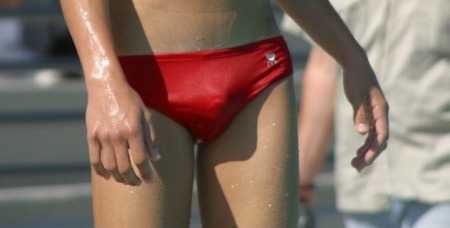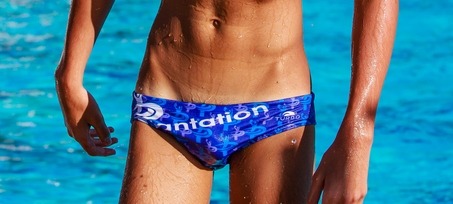
 |
|
|
|
#1
|
|||
|
|||
|
A little editorial hot off the press and posted here. I hope it's not offensive :P
Baffle of the Bulge It’s bad enough that so many photos of swimmers and divers and water-polo players are so unrevealing. Where you’d see full-body shots of soccer and football players, your typical swimmer is shown cropped at the waist or depicted as a waterlogged cranium splashing away in a pool, sans bawd. And even in photos that show a little below the waist, strange coincidences appear more often than not: A sitting swimmer’s head blocking the suit of a standing one, or a gesturing hand, a clipboard, a diving board, or simply a view of back sides only. Indeed no photography of any sport is so cloaked and privatized as that of an aquatic one. Which frustrates those who enjoy looking at suits and what’s in them — bulges, to use the technical term. This blind spot is a transgression, to be sure, but it’s getting worse. Because now, even when you’re lucky enough to see it in detail, the modern bulge is becoming even more cloaked and private, and for one big reason: Turbo. A bulge is an imprint of shapes, contours, dimensions, and directions. If you’re a longtime student of bulges, you can read the language of those imprints on a Speedo suit, or a TYR suit or a TruWest suit very well. You know immediately how plump a sack is, whether one side of it is a bit higher than the other, and whether its adjoining tubing is pointed straight up, straight down, or off to one side. You can judge the likelihood that it stands straight up or leans left or right when aroused. And you can tell if it ends somewhere and a head begins, or if the skin seems to proceed to the end of the line — in other words, whether a bulge owner is cut or not. After deciphering the clues, you can decide whether a swimmer suits your taste, because you now know exactly what he has to taste. The trouble is that not everybody’s wearing those suits like they were 10 years ago. They’re wearing Turbo. The Turbo suit is a blanket of heft and thickness that paves over a bulge so heavily as to render it shapeless and mute, as if a drag queen had slathered a bottle of concealer across it. So now a swimmer who in 2000 would’ve had a TYR bulge with a distinct sack, topped off with a downward-pointed cut dick almost three inches soft (see photo), instead has a Turbo bulge composed of a smooth goose egg — no other shapes, contours, dimensions or directions.  What’s worse is that many of these suits are throwing yet another “curve” at the bulge analyst: Where sunlight and visibility might be adequate to take some readings even on a thick Turbo suit, the growing use of colors and patterns across the bulge is camouflaging it beyond analysis. These suits are often splattered with multi-colored graphics whose designs — what a coincidence — directly bisect the bulge in 10 places, rendering it an abstract mosaic that warps light — light that, were it hitting a solid-colored suit, would expose a dick in more detail. Even seasoned bulge analysts would have better luck looking through a cracked windshield.  Turbo vs. TYR: What’s inside the TYR is suit is obvious — a cut dick, pointed down. The Turbo only shows a “goose egg,” creating much more guesswork. Turbo indeed. Turbo is a 50-year-old Spanish company that perhaps finally has a little buyership because it happened to be the “official outfitter for 2012 USA Olympic Water Polo teams.” It practically boasts of its bulge-concealing thickness and patterns, extolling that it’s the “originator of dye-sublimated competition swimwear” that “uses the world’s toughest anti-chlorine fabric.” In other words, thick fabric full of patterns that hide your glossy wet dick. It would seem that the company has a history of obscurity — not just obscuring — since it’s not even mentioned on Wikipedia’s “List of notable swimwear brands” as of this writing. Speedo is there. Arena is there. And Agon, Dolfin, Head, Hurley, Rip Curl, and TYR. A search at nifty.org, which archives stories about swimmers and their gay relationships, shows “Speedo swimsuit” appearing in stories from 1996 onward. The term “Turbo swimsuit” or “Turbo suit” doesn’t appear at all. But as of 2014, one developing story on mensswimsuitboard.com follows several swimmers with Turbo suits — a sign of the times. Turbo is new, and it’s here. And it’s burying more and more bulges in the very obscurity it is emerging from. A Turbo suit’s weight alone is a big telltale. A Size 32 Turbo King of Hearts suit weighed in at 73 grams here at the seriousaboutspeedos bulge lab. A Speedo of the same size, 54. Around 51 for a TruWest double-layer nylon suit. So a Turbo suit is practically 30% heavier than swimmers’ traditional gamewear. This trend of bulge cryptography is unorthodox. It’s been suspenseful and mysterious, certainly, but it’s time to return to traditional values, as the conservatives say. Maybe it’s time to cut the liners out of the Turbo suits — if they must be used at all. And time to return to solid colors. Half the reason to be in an aquatic sport is to display one’s body, to grow self-esteem by revealing it to spectators who appreciate it, to showcase it to your teammates, and to be photographed standing up, out of the pool, unabashed, and have something for a scrapbook besides a head splashing in the water. Last edited by db7178 : 06-08-2015 at 08:26 AM. |
|
#2
|
|||
|
|||
|
Commedians Peter Cook and Dudley Moore used to hold long rambling discussions on the show Not Only But Also.
One week they discussed the phenomenon of whisps of gauze floating down and hiding the modesty of otherwise naked models just at the moment that they were being painted. They asked the question of what had become of all the paintings in which the whisp of gauze had fallen upon the naked model but had missed the crucial sensitive spot and so revealing all. Your description of swimming on tv where the camera keeps just failing to linger on a male swimmers swim brief. In avoiding filming this area they only make the subject more mysterious and indecent. |
|
#3
|
|||
|
|||
|
Could not sgree more. The swimmers pelvis ALWAYS seems to be hidden behind a banner of some kind either with race results or the swimmer's races specs.
|
|
#4
|
|||
|
|||
|
I like the write up, it is well written and lays out its facts well. It is interesting that the writer claims that Turbo's thick material is intended to hide and conceal the bulge. Actually, the desire for thicker material has been a staple of water polo for years. Before suits like Turbo became popular, polo players often double suited to protect from the abuse they took under water. The thicker Turbo suits, and many brands like them, eliminate this need. It is also why there really is a distinction between "water polo suits" and mere "swimsuits." To be sure, my Turbo suits do feel thicker on, but I also have some Speedo suits designed for polo that are equally as thick on. As are my Zumo suits.
That said, I can assure you my maleness is just as proudly on display in my Turbo suits as any other. In fact, in the pictures above, the guy in the blue print looks just as male as the guy in the Tyr, in my opinion. His bulge is just as noticeable. I admire that Turbo has brought some color and pop to men's swimsuits, a trend that now seems to be coming into the more mainstream brands. The days of boring solids and splices are over (for now). Turbo suits are fun and exciting to wear. Contrary to the opinion that the thicker suits mask my maleness, I actually think the bright and bold looks attract the eyes right to my anatomical features. If bold prints and thicker material get more guys into cool swimsuits, I say why not? If it makes them feel more secure, great. My two cents. STS |
|
#5
|
|||
|
|||
|
I agree with STS - I think Turbo suits are HOT! Yes, the material is thicker because polo players need tougher fabric due to the physical roughness of their sport. But Turbos are also fairly skimpy - with about 2" sides compared to the 2.5-3" sides of most swimsuits. And the colors and patterns are really nice as well.
|
|
#6
|
|||
|
|||
|
I always appreciate a good laugh over twisted logic. The fact that swimmers are generally photographed from the chest or waist up is that it is the only time you can actually see their faces. If they photographed them from the waist down -- as you are suggesting -- it could be anyone on the team. Interviews with guys when the camera is on their crotch and not their face isn't as effective when discussing their performance. While getting farther away would show off their manhood, the interviewer and the swimmer would be too far to be effective and also most likely have people walking in front of the camera.
During actual swimming events the only part of the swimmer that is real view is the head and shoulders so that is the logical place for the camera. In soccer or other sports the feet are where the action is and having long body shots are more effective. Since they are also contact sports you see the men actually touching and hand placement is the interesting shot. (as we have all seen wrestlers and footballers grabbing a handful of manhood from time to time) Sports casters and cameramen are there to record the action of the sport and talk to the athlete. Sport shows are there to see the action of the sport and talk to the men playing - not to titilate the crotch watcher. If you are looking for a fashion show you should go to Youtube where there are a myriad of fashion shows for swimwear and underwear -- a bulge watchers paradise. |
 |
| Thread Tools | Search this Thread |
| Display Modes | |
|
|